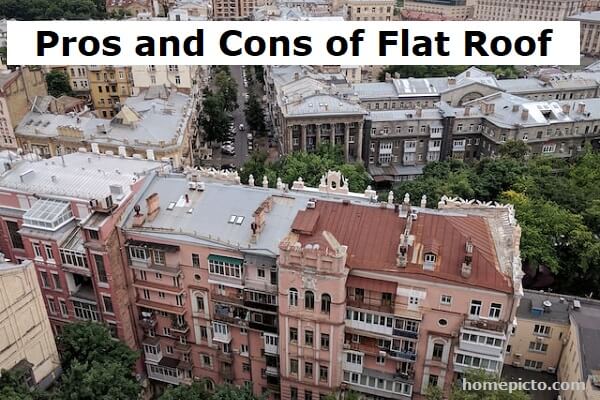We'll talk about flat roofing in this blog post. We are here to inform you about the pros and cons of a flat roof.
The design of a flat roof offers both advantages and disadvantages. These can include things like accessibility, ease of adding a home addition, safety, drainage problems, and more. See them listed below.
Flat roofs are less expensive and less adequate in terms of payment. Flat roofs are less costly in terms of both materials and labour. The large-sheet installation will require little time. We need more material for pitched roofs and utilized to store the equipment or an additional bedroom. The listed top prevents expansion, necessitating expenditure for remodeling.
If you wish to add another storey, a flat roof streamlines the procedure and reduces costs.Flat roofs are the preferred choice if you need to create an addition. Only attempt the flat roof on your own, even when it sounds easy. Consult a qualified roofing contractor for assistance.
With flat rooftops, there are numerous opportunities to profit.On a level area, a garden can be grown; it's environmentally friendly. We can use the rooftop area as a dining area. A flat roof helps conserve energy and cools the space below. Consider putting up solar panels.
Maintenance of flat roofs is simple and less dangerous. On a flat top, you can swiftly construct a parapet wall. Even if you walk on a material repeatedly, it will sustain less damage.
A house seems more contemporary when it has a flat roof. Every type of landscaping or theme is appropriate for a flat roof. It makes any interior design appear elegant and vintage. It would help if you had a design inspiration collection since flat roofs are becoming more popular.
Flat roofs have many downsides, including the potential for damage or leaks, durability, instability, and modern appeal.
A homeowner recently asked for advice on whether it was worthwhile to purchase a property with a flat roof.We advised him to spend the extra money to purchase a home with flat roofs.
If constructed and maintained correctly, a flat roof may stay intact. A high-quality craft ensures that it is oriented correctly for efficient water runoff and is inspected to find any damage or leaks.
The flat roof's primary drawback is that, due to its design, it receives more sunshine during the day. The angles of the pitched top cause it to receive less exposure.
This disadvantage only bothers you a little because reflecting roof coverings can shield a flat roof from the sun's heat. Utilizing reflective roof coatings is a practical way to protect your roof from the sun's heat.
The buyer is conscious of the flat roof's short lifespan and impending replacement in 10 to 15 years, which may make it more challenging to sell the home.
Due to improper drainage, flat roofs are less stable and can't handle the weight of snow and water, which might cause leaks along the wall.
The design and aesthetics of a flat roof are irrelevant because they need more appeal. Flat roofs are more about utility than aesthetics. They are available in neutral shades, including black, white, and grey.
Let's examine the types of flat roofs that can install on homes after discussing the benefits and drawbacks of flat roofing systems. A worn-out roof may require replacement.
In recent years, flat concrete roofing has not been very popular. It was in the past. The flat concrete roof's main advantage is that it can withstand strong winds; however, it has issues with chipping and fading and requires additional support.
To build a torch-down roof, which requires competence, you will need a roofing contractor with experience.Another name for a torch-down roof is "modified Bitumen."Heat is needed to install this roof; if it does not exercise caution, there could be fire hazards. You should engage the best or most qualified business to implement this project. When it's cold outside, this roof works great. Additionally, it will lower your energy costs.
A sustainable choice, EPDM flat roofing is made of synthetic rubber. It is the most reasonably priced balanced roofing system. Just adhesive is required to install this roof. The procedure is quick and straightforward, beneficial to the homeowners, and causes little disruption.
Commercial property owners are the primary users of an EPDM roof, which is excellent for residential homes.
Choose a TPO flat roofing system if you want an energy-efficient material that keeps your home cooler. TPO roofing systems are dirt-free and resistant to algae.
Conclusion
Our discussion of the benefits and drawbacks of flat-roof buildings is now complete. You require professional advice from a roofing contractor before beginning your roof project.

The major problem with a flat roof is its poor drainage. Although flat roofs have a slight slope, it does not drain water as effectively as a pitched roof. Water will continue to pool on that flat roof surface, possibly causing a leak or material damage.
Compared to most sloped roofs, flat roofs are more adaptable, simple to maintain, and energy efficient. Long-term ownership has cheaper costs, which benefits new house builders.
1. Less expensive than pitched roofs.
2. There is a place for HVAC units; additional space for various purposes.
3. A quicker and less intrusive installation procedureInstalling solar panels.
4. Drainage issues; EPDM's lack of style and attractiveness; (ethylene propylene diene terpolymer)
A slanted roof needs less upkeep than a level roof. As long as you take care not to harm the roofing, walking on a flat roof is safer than one that slopes; it's simple to keep functional.
A built-up roof requires waterproof material made of hot tar and gravel lasting up to 15 to 20 years. Tops have a lower average lifespan of 10 to 15 years and are composed of three to five layers of modified bitumen.